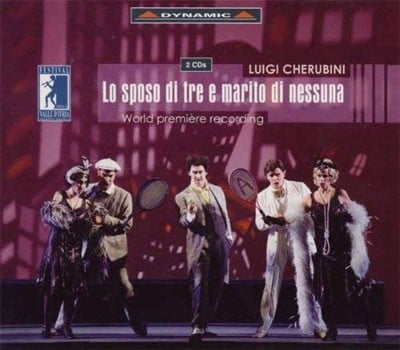Lo sposo di tre e marito di nessuna
(The Betrothed of Three and the Husband of None) (1783)3S,T,3Bar; 2.2.corA.0.1-2.0.0.0-continuo-strings
Abbreviations (PDF)
Anton J. Benjamin / Simrock
Cherubini’s Lo Sposo di tre e marito di nessuna was a big success – indeed, the composer’s first successful opera buffa. The work, which was premiered at the Teatro di San Samuele in Venice in 1783, showed Cherubini’s talent for the “other” opera genre, the burlesque, the comic opera, or dramma giocoso. He based his piece on a popular, satirical and parodistic drama, Goldoni’s La bottega del caffè. This burlesque play about dressing up and mistaken identity draws heavily upon the tradition of the Italian commedia dell’arte, with the pair of actors, the reflections on the love-stricken elderly gentlemen, the parody of Pantalone, the advocate scene, etc.
The music of this opera is a cavalcade of highly amusing, sometimes also deadly serious ensemble scenes which are effectively orchestrated. This is illustrated by the big chain finali, in particular the finale of the first act, in which all those involved eventually end up in a state of delirium which is accompanied by a delicious parody of thundering organ sounds, or the ombra scene, a spooky, bogus consultation with a ghost in the second act. On the other hand, there are highly virtuoso, sometimes touching arias that demand great skill from the female protagonists, Donna Rosa and Donna Lisetta, both of whom are seria characters. The male protagonists range from the wonderful baritone buffo Don Pistacchio, who also needs to be a very good actor, to the tenor Don Martino, a character who is sometimes portrayed in a rather sentimental way. Originally, two ballets were planned to form part of the opera, as an introduction and conclusion. The interpretation of these are now left up to the individual production – just as it was in Cherubini’s times.
"First performed in 1783, three years before Mozart’s Le Nozze di Figaro, this playful, charming score foreshadows much of the rhythmic vitality of the later masterpiece’s score… The storyline points a little further ahead, however, to some of the cynicism about human amatory impulses depicted in Così fan tutte… An opera well worth reviving, both for its inherent musical quality and the insights it provides to a rich era of operatic history.”
Opera Today

Festival della Valle d’Itria, Martina Franca 2005 (FP of new edition)
Dynamic CDS 503/1-2
Click here to purchase this CD from Amazon
